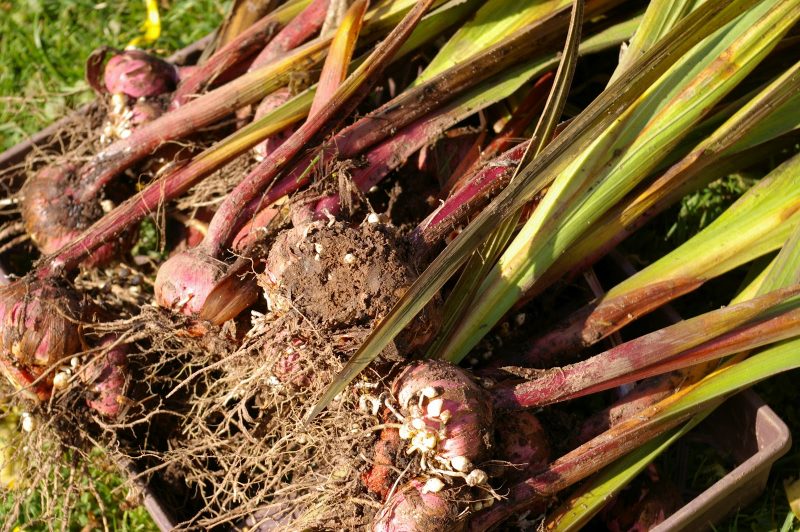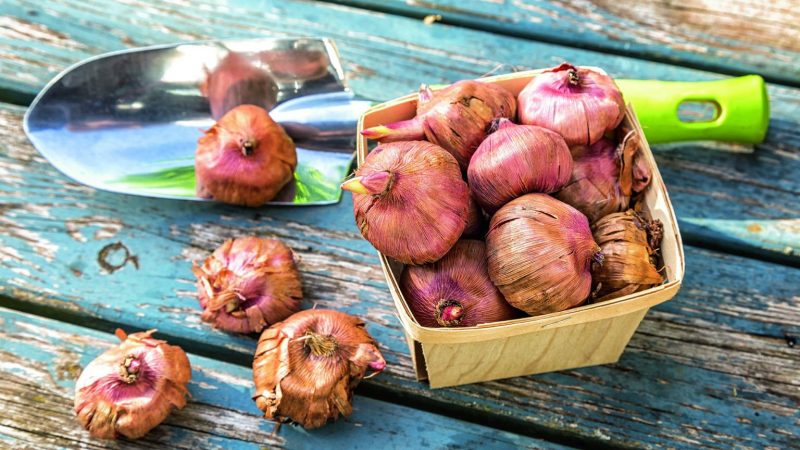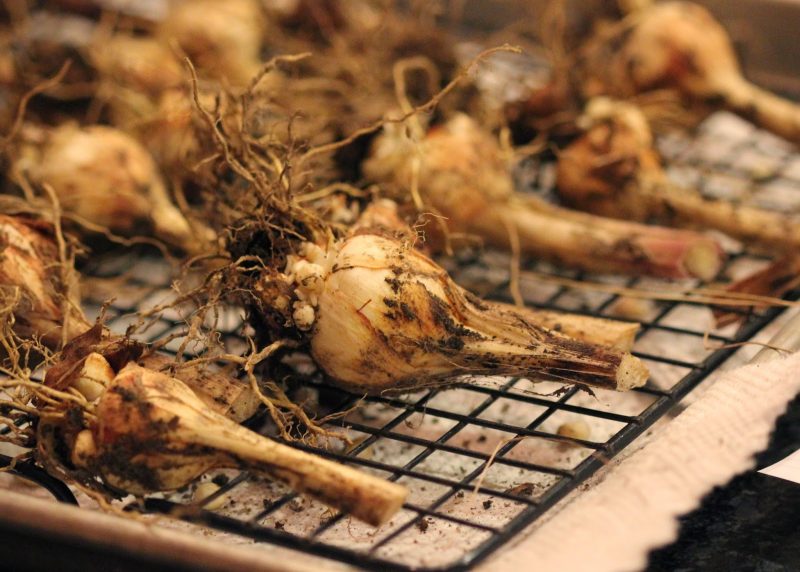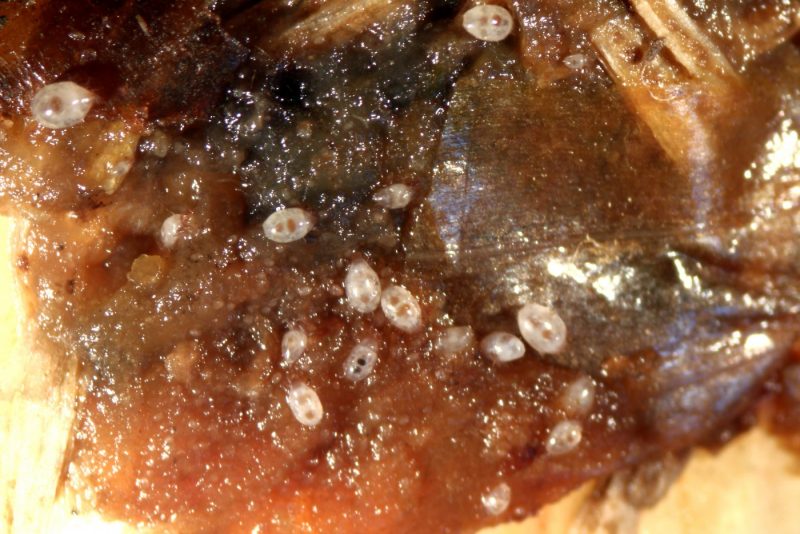Gladiolus is a perennial plant, but not every region will be able to winter in the open ground. In cold and humid soil, it will at least get sick, and in the worst (and most likely) soil, it will first freeze, and in the spring it will rot and die. And those bulbs that do not die will go to feed rodents. Then a logical question arises: how to store gladioli in the winter at home?
Material Content:
How is the digging of gladiolus bulbs
Some gardeners think that it is possible to dig up a corm immediately after flowering of a gladiolus. But this is not true. So the plant is deprived of the opportunity to accumulate nutrients. During flowering, they are only consumed, and accumulation begins after.

So when to dig out? When the last flower fades, cut off the arrows (only the part where the flowers were, and leave the leaves) and start counting for three weeks. After the specified period, you can perform the procedure. Focus on the end of September - the beginning of October.
Digging should be, backing at least 15 cm from the plant, so as not to damage the bulb and the children that have grown on it.
The procedure is as follows:
- Make a deep digging with a shovel.
- Holding the stem by the base, hands pull the bulb from the ground.
- By delicate movements we clear of large earth clods.
- Next, the bulbs must be properly processed in order to prepare for storage.
On a note. Some varieties have frost resistance to a greater extent than their relatives. Acquiring a certain type, carefully study the characteristics of the plant.
Drying and processing bulbs for the winter
When wondering how to preserve gladioli in the winter, it is important to consider that the bulb preparation stage plays an important role in this process.

In order for the planting material to live safely until the next season, after digging it out, the following manipulations should be performed:
- tear off the roots, but in no case cut off with a knife;
- carefully remove the daughter bulbs;
- treat the tubers with an antifungal drug;
- cut the stems;
- dry so that no moisture remains on the surface.
The most popular antifungal agents: Phytobacterin, Phytosporin, Maxim, Fundazol. Bulbs peeled from the roots and children are immersed in the solution for the time prescribed by the instructions of the selected preparation. The stems remain in the air. For lack of a purchased chemical, you can use a weak potassium permanganate solution, soaking time is 20 minutes.
The gladioli processed in this way are removed from the solution by holding the stems. Then they are cut off, departing 1 cm from the corm, and the finished heads are folded to dry on a dry, shaded, well-ventilated surface for two weeks.
After drying, it remains only to pack planting material in a cardboard box with holes for air exchange.
At what temperature do bulbs of gladioli be stored
The best storage temperature is from 3 to 9 ° C above zero.

Such conditions may provide:
- lower shelf of the refrigerator;
- basement with ventilation;
- cellar;
- glazed insulated balcony;
- vestibule;
- “Winter refrigerator” if the apartment is an old building (box under the windowsill).
It’s important not only the air temperature, but also humidity control. From high humidity, the bulbs rot, from low humidity they dry out. The optimal indicator is 70% (plus or minus 10%). For control, you will have to purchase a hygrometer.
To increase humidity, keep a bucket of water indoors.
Of course, there are electric humidifiers, but they will give too much moisture.
Features of storage in the winter in the cellar
The main problem of the cellar is excess air humidity.

What can be done to lower it:
- periodically ventilate the room;
- install a special household appliance dryer;
- buy a moisture absorber.
The most interesting moisture absorber made by yourself. Usually it is calcium chloride in a container. Using it is extremely simple: remove the cover and put it in the right room. The only negative - the container will work for one month, after which the contents of the box are filled with moisture and you will need to install a new absorber.
In severe frosts, control the temperature in the cellar. If it falls below 3 degrees, it is worth temporarily moving the gladioli into a warmer room, or at least covering them with a thick blanket.
It is interesting:how to plant gladioli
How to store in the refrigerator
For wintering in the apartment, the bulbs of gladioli are ideally placed in the drawers for vegetables, which are usually included in the refrigerator set and are located on the lowest shelf. For lack of boxes, the bulbs are stacked in a cardboard box with ventilation holes, a net or simply wrapped in newspaper with each tuber.

It is advisable to spread the bulbs in one layer so that they do not touch each other. Every two weeks, examine them for mold. If one is found from the bulb, it is necessary to erase the coating, dry the tubers for 1 to 2 hours near the battery, and then return it to the refrigerator shelf.
On a note. Gladioli are better preserved if each head is additionally wrapped in paper.This technique helps maintain an optimal environment - the paper holds a certain bulb temperature, and also absorbs excess moisture.
Pest protection of tubers
The main enemies are insects: thrips and bulbous (barn) ticks. An onion tick is also dangerous for humans, it causes itching and dermatitis.

It is necessary to control the presence of pests all the time: both in the flowerbed and during the wintering period. If you notice crawling or flying insects next to flowering gladioli, you must immediately begin etching. This will give a chance to get rid of them at the time of digging and prevent damage to the bulbs.
What can be done:
- Carry out the processing of pesticides ("Aktara", "Corado", "Biocill").
- There are also preparations based on plant extracts (Extraflor). The needles and wormwood included in their composition scare away the pests.
In addition to protection from insects, herbal remedies support the plant:
- stimulate growth;
- increase vitality;
- contribute to abundant flowering.
In addition, they are not dangerous to humans.
As for the hibernation, the key protective measures are taken immediately after digging.
To do this, you need:
- remove old scales, roots, cut diseased areas with a sharp knife;
- to make a careful rejection, not to store weak, rotten, rotten bulbs - they are the most vulnerable;
- throw away specimens already affected by insects;
- Treat the excavated material with insecticides, strictly following the instructions.
If infection has still not been avoided, then do not plant the affected bulbs in open ground - even if they germinate, they will be sluggish, and pests will infect neighboring plants and the soil.












